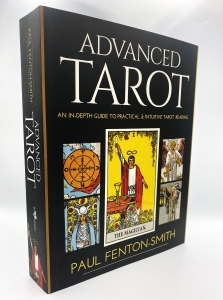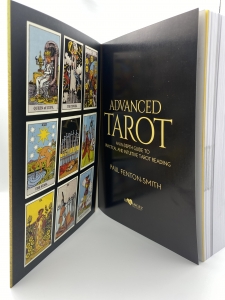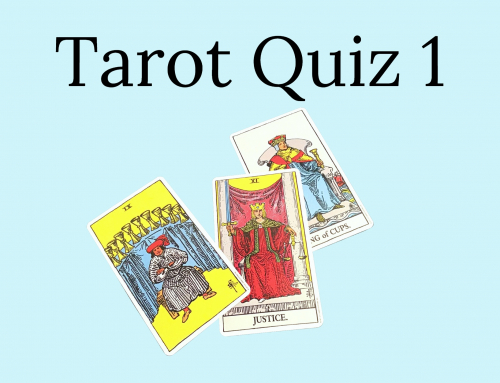Author and clairvoyant Paul Fenton-Smith advocates that to allow for life’s shades of grey, it is vital to include reversed cards in tarot readings. Using only upright cards limits the subtleties of insightful interpretations. Having no reversed cards in a deck can also increase inaccuracy when answering yes/no questions. A recent reading illustrates issue.
Clara knew just enough about the tarot to scare herself. Scanning the cards on the table, she noticed a few were reversed.
“These are reversed,” she said, staring at the layout. “Not good.”
I explained that some cards are more positive reversed, whereas for others, it can simply describe delays. She didn’t seem dissuaded from her train of thought. I persisted.
“When this card, the Ace of Wands is reversed, it can indicate that you’re impatient to begin something new but need to clear away unfinished projects first. Do you have room on your life right now for another project? If not, how can you make time for it?”
“I have a great idea that can be knocked over quickly,” she said impatiently. “Right now, I just need to score a few quick goals while a big project is stalled,” she explained.
As soon as she said this, I remembered my last great idea that could be knocked over quickly. It was an idea for a book. I told my editor that it would be 30 pages long and I’d have it done in 30 days. Through each careful revision, the editor asked questions, effectively revealing to me what was missing from my book. By the time my quick idea had been completed, it has taken more than eleven years and was 172 pages long. During this period, I wrote two other books and a correspondence course.
Some people feel that life is difficult enough without adding reversed cards but this is based on the assumption that all reversed cards are more detrimental than upright cards.
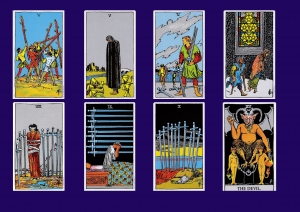 Some cards that are more positive reversed than upright include:
Some cards that are more positive reversed than upright include:
- all the fives, including The Hierophant
- the Eight, Nine and Ten of Swords
- The Devil.
Cards that are still encouraging, even when reversed include:
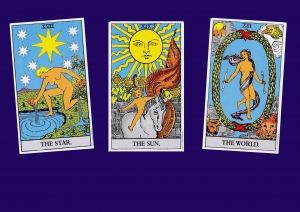 The Tower is an exception in that it is sometimes less serious in its effects when reversed than upright. This is a card for sudden, unexpected change that can be shocking. Often the chaos found in the reversed card is happening to someone else when this card appears reversed. A retrenchment thinning out office colleagues but not directly affecting your job is an example. Although you’ll lose some sleep and tiptoe around at work for a few weeks, you’re still employed. While former colleagues are searching for new jobs, you’re left grieving their loss and wondering how many more jobs might be at risk in the coming months.
The Tower is an exception in that it is sometimes less serious in its effects when reversed than upright. This is a card for sudden, unexpected change that can be shocking. Often the chaos found in the reversed card is happening to someone else when this card appears reversed. A retrenchment thinning out office colleagues but not directly affecting your job is an example. Although you’ll lose some sleep and tiptoe around at work for a few weeks, you’re still employed. While former colleagues are searching for new jobs, you’re left grieving their loss and wondering how many more jobs might be at risk in the coming months.
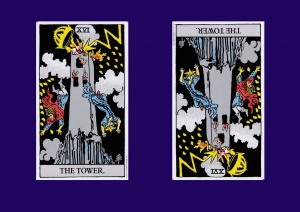 The argument that readings are more helpful when all the cards are upright overlooks their use for reflecting how circumstances have been in clients’ lives, how they are presently and how the future looks. If an individual is entering a long personal winter, being told ahead of time allows that person to prepare. This is even more significant when a country is entering a financial winter. During the global financial crisis, I read for many small business owners who desperately wanted to be told that business would pick up in a few months. However, it simply wasn’t true.
The argument that readings are more helpful when all the cards are upright overlooks their use for reflecting how circumstances have been in clients’ lives, how they are presently and how the future looks. If an individual is entering a long personal winter, being told ahead of time allows that person to prepare. This is even more significant when a country is entering a financial winter. During the global financial crisis, I read for many small business owners who desperately wanted to be told that business would pick up in a few months. However, it simply wasn’t true.
Had I suggested this, they might have left feeling unrealistically reassured. This confidence might have led them to splurge their last available funds or even borrow money to invest in advertising that wasn’t going to work. Depleting reserves of cash can be detrimental to any business, especially when the immediate future is not bright.
When people are anxious about recession, retrenchments and not being able to pay their bills, they usually close their wallets tight until the fear subsides. A business owner who anticipates a period of slow sales can trim stock levels, keep overheads low and postpone expansion plans until a financial spring arrives. Reassuring clients everything will be fine to make them temporarily feel better is irresponsible in these circumstances.
If a financial winter is approaching, it is essential to warn the client about what to expect. It is equally vital to look ahead and see what is likely to happen beyond the restricted period. Describing the personal spring ahead can provide reassurance for the individual to do what is necessary to keep business afloat until the next upswing.
The secret to knowing the reversed meanings for each card is this: a reversed card suggests the client is struggling to master the card’s lesson. To avoid feeling frustrated or overwhelmed, it usually benefits the person to return to the previous upright card (in the same suit, for minor arcana) to master the particular challenge it contains.
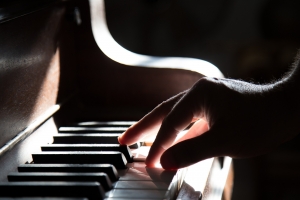 A metaphor for this might be learning to play an instrument. Toby’s level of enjoyment drops when he struggles with a new and unfamiliar sequence of chords and notes during a piano lesson. He begins to lose confidence and becomes impatient with himself. If the teacher pushes him through the process, he might feel overwhelmed. As a swords student, he’s likely to inwardly criticise himself, his lack of practice or his fingering technique.
A metaphor for this might be learning to play an instrument. Toby’s level of enjoyment drops when he struggles with a new and unfamiliar sequence of chords and notes during a piano lesson. He begins to lose confidence and becomes impatient with himself. If the teacher pushes him through the process, he might feel overwhelmed. As a swords student, he’s likely to inwardly criticise himself, his lack of practice or his fingering technique.
Before abandoning his piano lessons, if the teacher asks him to stop for a moment and return to playing a piece he can play with ease, he’s much more likely to enjoy a feeling of progress. As he plays a favourite piece of music, his confidence bounces back and his fingers regain their dexterity. When she feels that he is ready, Toby’s teacher encourages him to attempt the difficult piece again.
This is how it is with the tarot, too. Someone struggling to master the lesson of the Seven of Wands needs to return to the Six of Wands to rebuild confidence and familiarity with the stability it provides before returning to the Seven. The Six represents achievement resulting for planning, focus and effort while the Seven shows new strategies applied to manage greater responsibilities. When reversed, he is overwhelmed by increasing demands, so a brief return to fewer responsibilities, helps him to regroup.
Continuing with the piano analogy, learning each tarot card meaning is like studying the notes on a piano keyboard. When you need to find one or every D note on a keyboard, you know where to look for them. In tarot terms, you learn to recognise cards and distinguish between the Ace of Swords and the Ace of Cups.
Next in piano study, we learn scales. The notes in a scale are like the cards (ace to king) of a tarot suit. So, when playing in the key of G, it’s possible to know which notes fit harmonically into the song. Then we learn chords. Chords are groups of notes that blend together to form a rich, full sound. Chords are like card layouts. A reader might use a three-card layout or a seven-card spread to answer a question.
More experienced piano students learn to read music so they can play songs or scores from sight. In tarot terms, this is like reading a layout and interpreting the significance of each card in combination with the other cards in the spread. Just as a piece of music has a mood, a tempo and a theme, so too does each tarot layout.
Eventually Toby learns to play a complete piece of music – perhaps a whole song or several songs. In tarot terms, this is like giving a complete tarot reading. Each card has a specific meaning in a particular layout and several layouts make up a reading. A full tarot reading is like a whole concert event or a live music experience, clients usually want to listen to it again. That’s why recordings are essential.
During a full concert, the musician uses the score as a guide and is capable of acting on inspiration or intuition to give a unique interpretation to a song. Likewise, an experienced tarot reader is able to smooth out the highs and lows in a reading for consistency, ensuring a positive experience for each client. When paying a higher fee for a more experienced reader, you’re often investing in that person’s skills developed through years of practice readings.
Learning basic card meanings is essential but these definitions are not always helpful during a reading. It’s necessary to step back and see the whole layout to decide how each card fits with the others to form a complete picture.
In the 1980s, I visited an art gallery in London to see an exhibition of Claude Monet paintings. Enormous canvases were positioned around the room and unwittingly, I stood too close to each painting to see it clearly. I was so close that all I could see was dots and brush strokes. Disappointed, I decided to leave. As I reached the exit, I turned to glimpse the room one last time and was stunned by the beauty of the huge paintings. At that distance, I was surrounded by the subtle hues of glorious gardens captured in soft sunlight. I stood transfixed; by stepping back, it suddenly made sense.
People consult tarot readers and clairvoyants to have someone who is objective peer into their lives. Readers are hopefully at a distance where they can see what has happened, plus events that are currently unfolding along with what’s likely to occur in the future. Reading upright and reversed cards helps clarify the picture a reader presents to clients. Hopefully, this image includes the strong blacks, whites and a range of softer hues. © 2020 Copyright Paul Fenton-Smith.
Paul Fenton-Smith is the author of 11 books and has been the principal of the Academy of Psychic Sciences in Sydney since 1985. He runs a busy private practice in Sydney as a counsellor, clairvoyant and clinical hypnotherapist and teaches courses based on each of his books. This text is from his recent book Advanced Tarot.
